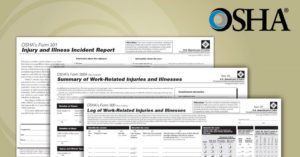January Safety Tip
FEDERAL OSHA RECORDKEEPING
OSHA requires employers to record and report work-related fatalities, injuries, and illnesses. This doesn’t mean that the employer or employee was at fault or that an OSHA rule was violated or that the employee(s) are eligible for worker’s compensation or other benefits. These records are used for several purposes including:
- Injury and illness statistics are used by OSHA to help direct it’s programs, measure it’s own performance and inspectors use the information to help direct their efforts.
- The information can be used by employers to implement safety & health programs and track progress
- It provides a data base for the BLS (Bureau of Labor Statistics – the Nation’s primary source of occupational injury and illness data)
Not all employers must keep records – if there were more than 10 employees at any time you must keep records (unless your establishment is classified as partially exempt. But everyone must still report fatalities, loss of an eye, amputations, hospitalizations, including related to COVID-19.
So what is required of an employer? In general employers must complete every year:
- OSHA Form 300 or “Log”
- OSHA Form 300A “Summary”
- OSHA Form 301 or equivalent
- Sharps Log (May not be applicable to all employers)
- COVID-19 log (Subpart U – ETS Healthcare)
- Electronic submission (may not be applicable to all Employers– effective 1/1/2017)
How about reporting items to OSHA? The following must be reported to OSHA within the timeframe specified:
- Fatalities (within 8 hours)
- Hospitalization of 1 or more employee (within 24 hrs.)
- An amputation (within 24 hrs.)
- A loss of an eye (within 24 hrs.)
- Fatal heart attacks that occur in the work environment
- Healthcare (COVID-19 ETS):
- COVID-19 fatality within 8 hours
- Covid-19 inpatient hospitalization within 24 hours
- Mechanical power presses: POO (point of operation) injuries to operators/ other employees must be reported within 30 days of occurrence
Not every injury is recordable according to OSHA. To become a recordable case it must meet at least one of the items listed below (at any time – not just at the initial injury onset):
- Death
- Days away from work
- Restricted work or transfer to another job
- Medical treatment beyond first aid
- Loss of consciousness
- Significant injury or illness diagnosed by a physician or other licensed health care professional
Also keep in mind that recordable cases may happen outside the workplace, too. Injuries or incidents that fit the above criteria may be recordable even if it happened while the employee was working at home, traveling for work, or at another worksite because of work. You may also have to record injuries or illnesses for contract workers (if you supervise their activities).
Some other highlights of recordkeeping include:
- For work-related COVID-19 cases make sure these are recorded on the 300 Form as a “respiratory illness”
- Do ensure you readily have available the current year documents plus the prior five (5) years’ worth as well.
- There are also some special recordkeeping requirements for employers that fall under Subpart U – the healthcare emergency temporary standard.
- Although temporarily stopped Federal OSHA also has some requirements for COVID-19 cases.
- Make sure that all cases that meet the recording criteria are put on the 300 Form within 7 calendar days that you are notified of it.
- For days away from work and restricted/alternate work days count calendar days, not just the days the employee(s) were to work.
- You can stop counting or cap the total days away from work, or the total days of alternate duty, or combination of both if it totals 180 days. Put “180” or “180+” on the form.
- Make sure the highest ranking person at your establishment signs the 300A Summary!
Help is here!
ICE may help you save a lot of time with recordkeeping. Not only can it produce the necessary documents but you also have the ability to make adjustments as a case changes. One of the best features is the iCE Auditor which will review your OSHA Form 300 for potential errors or inaccuracies allowing you to make corrections before you post the 300A Summary.
Forms: iCE can produce the OSHA Form 300 or log; the 300A Summary, 301’s, and the format necessary for electronic submission
Corrections: iCE allows you to go back and make corrections, such as the numbers of days away from work or transitional duty, job titles, injury/illness classification and many more options.
Resources: https://www.osha.gov/recordkeeping
https://ice.ccmsi.com/iCE/OSHA/OSHAForms.aspx

